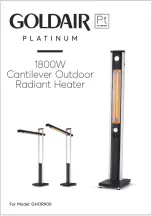
Direct Gas Make-Up Air
35
Start-Up: Direct Gas-Fired Heating
Optional Features
Variable Air Volume (VAV)
(continued)
minimum airflow, the bypass damper will be mostly
closed and a majority of the air will pass though the
burner profile. In this way, the airflow through the burner
profile remains relatively constant through the range of
airflow operation.
Due to the movement of the bypass damper throughout
the airflow range of the unit, a change in RPM does
not result in a directly proportional change in airflow. In
these units, a 33% fan RPM reduction results in a 50%
airflow reduction.
Burner Pressure Differential Check
The bypass damper is designed to open and close to
maintain the correct pressure differential through the
burner profile for proper operation. The counterbalance
arm and weights are factory adjusted for the correct
pressure drop and do not require field adjustment. In
many cases, the bypass damper is able to compensate
for variations in supply airflow and no adjustments to
the burner profile are necessary.
Reference the
Start-Up:
Direct Gas-Fired Heating,
All Units
section in this Installation, Operation and
Maintenance Manual for more information
about
measuring burner pressure differential and adjusting
burner baffles. Before making any adjustments to the
burner baffles on a variable air volume unit, check
the burner pressure differential with the supply fan
at maximum speed and again with the supply fan at
minimum speed. The burner pressure differential will
vary slightly throughout the range of airflow. Verify
that the burner pressure differentials at maximum and
minimum speed are both in the correct range:
• Natural Gas: 0.5 to 0.8 in. wg
• Liquid Propane (LP) Gas: 0.7 to 1.0 in. wg
If adjustment is necessary, adjust the fan RPM via
adjustable motor sheaves (if equipped), VFD, or sheave
replacement to achieve proper burner pressure drop.
Motor amp draw must not exceed full load amperage
(FLA) on motor nameplate. If fan RPM cannot be
adjusted, evenly adjust the baffles above and below the
burner, keeping the burner centered in the opening until
the required pressure is obtained.
















































